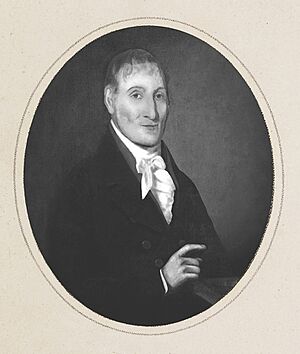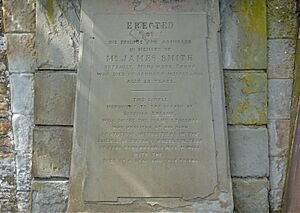James Smith (Scottish botanist) facts for kids
James Smith (born 1760 – died 1 January 1848) was a Scottish botanist and nurseryman. He created the Monkwood Botanic Garden in Maybole Parish. This garden had thousands of different kinds of plants, both from other countries and from Great Britain. James Smith often shared his knowledge with other plant experts in England. He is known for finding new plant species like Primula scotica and Salix caprea pendula. Because he was so interested in the plants of Scotland, many people called him the "father of Scottish botany."
Contents
Who Was James Smith?
Early Life and Training
James Smith was born in 1760 in Ochiltree, Scotland. When he was younger, he studied with a famous botanist named Joseph Banks. He also worked in the gardens of grand places like Stowe House and Syon House. Later, he became the manager of the London Botanic Garden for William Curtis.
In 1784, Smith returned to Scotland. He brought many plants that Curtis and others had given him. An old newspaper, The Ayr Advertiser, said this was the "first private collection of plants in Scotland." It was special because it was organized using the Linnaean system, which is a way to classify living things.
Building His Famous Garden
When Smith first came back to Scotland, he used a garden that later became part of the old church graveyard in Ayr. After that, he started a plant nursery at his home on the Monkwood estate, near Minishant. This place eventually grew into the Monkwood Botanic Garden.
By 1825, this garden had more than 3,500 different types of plants. These included both plants from other countries and native Scottish plants. It was at Monkwood that Smith hired and taught his future son-in-law, a botanist named John Goldie. A fern called Dryopteris goldieana is named after Goldie.
The poet Hew Ainslie visited Monkwood in 1820. He wrote that Smith's garden was "paradisiacal," meaning it was like paradise. He said plants "of all nations were seated most brotherly together," sharing the same dew and dancing in the same breeze.
Discovering New Plants
Because James Smith knew so much about plants and had such a large collection, other famous botanists often asked for his advice. These included William Jackson Hooker and James Edward Smith. They used his information in their own books.
For example, in Hooker's book Flora Scotica (1821), James Smith is given credit for finding several new plants. These include the beautiful Primula scotica, Veronica hirsuta, and the Kilmarnock Weeping Willow (Salix caprea pendula).
A Legacy in Botany
James Smith passed away on January 1, 1848, when he was 84 years old. His gravestone in the Ayr Auld Kirkyard (where his first garden was) calls him the "father of Scottish botany." This title shows how important his work was in studying and understanding the plants of Scotland.
By the end of the 1800s, the house and garden at Monkwood were gone. However, many of the rare plants that Smith collected still grow on the land today.



